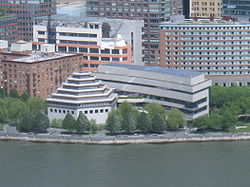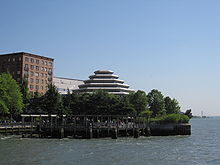- Museum of Jewish Heritage
-
- Not to be confused with the Jewish Heritage Museum.
Coordinates: 40°42′22″N 74°01′08″W / 40.706211°N 74.018750°W
Museum of Jewish Heritage
Aerial view of the Museum of Jewish HeritageEstablished 1997 Location 36 Battery Place, Battery Park City • New York, NY Type Holocaust museum, Jewish museum Director David Marwell Public transit access Buses: M5, M15 SBS or M20 to South Ferry
Subways: Bowling Green

Broad Street

Website mjhnyc.org  The Museum's Robert M. Morgenthau wing
The Museum's Robert M. Morgenthau wing
The Museum of Jewish Heritage, located in lower Manhattan, is a living memorial to those who perished in the Holocaust. The Museum honors those who died by celebrating their lives – cherishing the traditions that they embraced, examining their achievements and faith, and affirming the vibrant worldwide Jewish community that is their legacy today. The building, designed by Roche-Dinkeloo, is topped by a pyramid structure called the Living Memorial to the Holocaust.
Since the Museum first opened its doors in 1997, visitors of all ages and backgrounds have gained a perspective on 20th and 21st century Jewish history and heritage. Now in its second decade, the Museum has welcomed more than 1.5 million visitors from all over the world.
The two Biblical quotes that define the Museum’s mission – “Remember, Never Forget” and “There Is Hope For Your Future” – also define the Museum's perspective on the events of the 20th and 21st century Jewish experience. Although the Museum centers on life before, during, and after the Holocaust, the obligation to remember is enriched and enhanced by a commitment to the principles of social justice, education, and culture in the Jewish community and beyond.
Included in the Museum are special exhibitions, public programming, and contemplative spaces, which are intended to enrich the visitor experience.
Contents
Exhibitions
Core exhibition
The Museum's collection contains more than 25,000 items about modern Jewish history and the Holocaust. Many of these items rotate into the Core Exhibition, while others are featured in temporary exhibitions. In addition, many can be viewed in the Museum’s searchable Online Collection.[1]
The Core Exhibition tells the story of 20th and 21st century Jewish life from the perspective of those who lived it. Through a rotating collection that includes artifacts, photographs, and documentary films, the Core Exhibition places the Holocaust in the larger context of modern Jewish history. It is organized into three chronological sections: Jewish Life A Century Ago; The War Against the Jews; and Jewish Renewal—each told on a separate floor.
The Core Exhibition is housed in a remarkable six-sided building —symbolic of the six points of the Star of David and the six million Jews who perished in the Holocaust.
Entry Rotunda
The visitor experience begins with a nine-minute, multimedia presentation that introduces the themes of the Museum. Combining vivid imagery, music, and multigenerational voices, this collage eloquently conveys the richness, diversity, and tenacity of Jewish life around the world.
Jewish Life A Century Ago
The first floor of the Core Exhibition explores vibrant and multifaceted Jewish life in the late 19th and early 20th centuries. Personal artifacts and family photographs accompanied by documentary films provide a rich emotional component to the exhibition.
The War Against the Jews
The second floor tells the story of Europe’s Jews confronting hatred and violence, of communities coping with persecution and isolation, and of their struggles to maintain humanity. These galleries present the history of the Holocaust from the point of view of Jews who lived through it, using their own artifacts, photographs, testimony, and historical footage. Chronological displays provide a framework for the historical events of the period.
Jewish Renewal
The third floor of the Core Exhibition focuses on how Jewish individuals and communities rebuilt their lives after the Holocaust and continue to thrive in the 21st century. The exhibition concludes with how contemporary Jewry has embraced the Jewish value of Tikkun Olam (Repairing the World) and fighting for justice for everyone.
Andy Goldsworthy’s Garden of Stones
Andy Goldsworthy’s living memorial garden, his first permanent commission in New York City, opened to the public on September 17, 2003. An eloquent garden plan of trees growing from stone, the garden was planted by the artist, Holocaust survivors, and their families. This contemplative space, meant to be revisited and experienced differently over time as the garden matures, is visible from almost every floor of the Museum. The effect of time on humans and nature, a key factor in Goldsworthy's work, is richly present in Garden of Stones, as the sculpture will be viewed, as well as cared for, by future generations.
Keeping History Center
The Keeping History Center, an ongoing exhibition, presents the Museum’s ideas and collections in a state-of-the-art, interactive, digital visitor experience. The Center occupies a 2,200-square-foot (200 m2) area that has panoramic views of New York Harbor and the Statue of Liberty. Perhaps more than any other space in the building, the Keeping History Center is the link between the Museum’s subject matter and its powerful symbolic neighbors. The Center features Voices of Liberty, a soundscape of diverse voices responding to arriving in America for the first time, including Holocaust survivors, Soviet refuseniks, and others. The Center also contains a virtual exploration of Andy Goldsworthy’s Garden of Stones called “Timekeeper.”
Fire in My Heart: The Story of Hannah Senesh
Among Israel’s most important heroes is Hannah Senesh, who died by firing squad in 1944 at age 23. This first-ever exhibition about her life tells how this Budapest-born poet, diarist, and author of the hymn Eli, Eli discovered her love for the Land of Israel, volunteered for a mission to rescue downed Allied fliers and Jews from Nazi-occupied Hungary, and became an enduring symbol of courage and determination. A companion website features poetry, a timeline, and artifact explorations.[2] The exhibition is on view through August 7, 2011.
The Morgenthaus: A Legacy of Service
Robert M. Morgenthau, Henry Morgenthau, Jr., and Henry Morgenthau, Sr. — three men who courageously spoke out against injustice when no one else would — represent more than a century of one family’s dedication to public service. Henry Morgenthau, Sr. became Ambassador to the Ottoman Empire at the outbreak of World War I, while Henry Morgenthau, Jr. served as Secretary of the Treasury during the Great Depression and World War II. As the longest-serving district attorney in New York City, Robert M. Morgenthau effected far-reaching change in the legal system, and inspired new generations of professionals and public servants. The exhibition explores the fascinating ways in which three generations of a family raised awareness of tragedy around the world, and in doing so changed the course of world events, American politics, and Jewish history. A companion website includes artifact explorations and biographical information. [3] The exhibition is on view through September 5, 2011.
Edmond J. Safra Hall
In the 375-seat, state-of-the-art Edmond J. Safra Hall, the Museum offers a full schedule of public programs that are both consistent with its mission and push the envelope. The Museum hosts films, concerts, and panel discussions throughout the year. Past programs have included symposia on the Holocaust, interfaith dialogues, and concerts featuring established and emerging artists.
Over the last few years, the Museum has held a day-long symposium on Darfur with policy makers and leaders on human rights, presented performers such as Idan Raichel and David Strathairn, and film screenings with actors and directors such as Kirk Douglas, John Turturro, Quentin Tarantino, Claude Lanzmann, and Ed Zwick, and explored Justice after the Holocaust with experts like Alan Dershowitz.
Affiliates
JewishGen
JewishGen is the leading internet pioneer for Jewish genealogy and provides free online access to a vast collection of Jewish ancestral records in a simple, understandable, and searchable format. For many Jews, knowledge of their family history perished in the Holocaust. JewishGen and the Museum affiliated in 2003, helping the Museum to fulfill its mission of memory and legacy. JewishGen features over 16 million records, 3 million family trees, 1.3 million burial records, hundreds of translated Yizkor (memorial) books, research tools, family finders, educational classes, and many other constantly updated resources.
Auschwitz Jewish Center
In addition to the New York campus, the Museum has also operated the Auschwitz Jewish Center in Oswiecim, Poland since 2006.
Before Auschwitz became the ultimate symbol of the Holocaust, it was just an ordinary Polish town known as Oświęcim. The majority of its citizens were Jewish. In September of 2000, the Auschwitz Jewish Center opened its doors to honor the former residents of the town and to teach future generations about what was lost. Located less than two miles (3 km) from Auschwitz-Birkenau, it is the only remaining Jewish presence in the town.
The AJC’s mission is also to provide all visitors with an opportunity to memorialize victims of the Holocaust through the study of the life and culture of a formerly Jewish town and to offer educational programs that allow new generations to explore the meaning and contemporary implications of the Holocaust. The Center provides regularly scheduled exhibitions and educational programs. The United States Service Academy Program takes cadets and midshipmen to Poland for a three-week trip to learn from survivors, scholars, and historians. The Auschwitz Jewish Center Fellows program is a three and a half-week study trip for students who are matriculated in graduate programs or are completing undergraduate degrees.
Fellowships at Auschwitz for the Study of Professional Ethics (FASPE)
Fellowships at Auschwitz for the Study of Professional Ethics (FASPE) is a set of innovative programs for students in business, journalism, law, medical, and seminary graduate programs. Fellows study the roles of their chosen professions in Nazi Germany and the Holocaust and use that historical focus as a framework for the consideration of contemporary ethical issues. FASPE is under the auspices of the Museum of Jewish Heritage.[4]
See also
Notes
- ^ MJH Collections
- ^ Fire In My Heart: The Story of Hannah Senesh
- ^ The Morgenthaus
- ^ [www.mjhnyc.org/faspe FASPE: Fellowships at Auschwitz for the Study of Professional Ethics]
External links
 Media related to Museum of Jewish Heritage at Wikimedia CommonsCategories:
Media related to Museum of Jewish Heritage at Wikimedia CommonsCategories:- Jewish museums in New York
- Jews and Judaism in New York City
- Museums established in 1997
- Holocaust museums in the United States
- Museums in Manhattan
- History museums in New York
- Buildings and structures completed in 1997
- Pyramids
- Roche-Dinkeloo buildings
Wikimedia Foundation. 2010.


